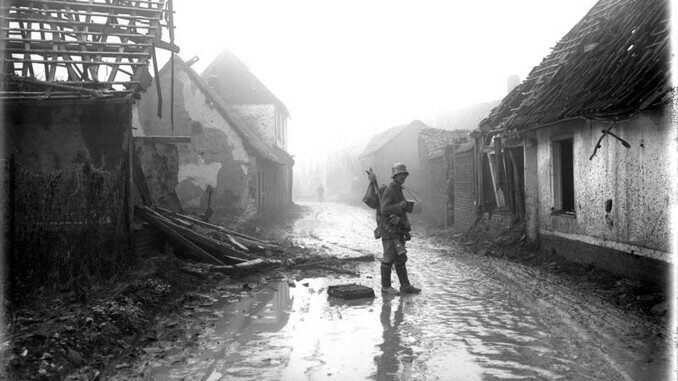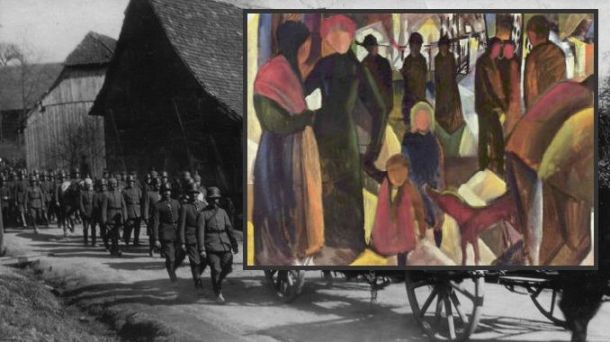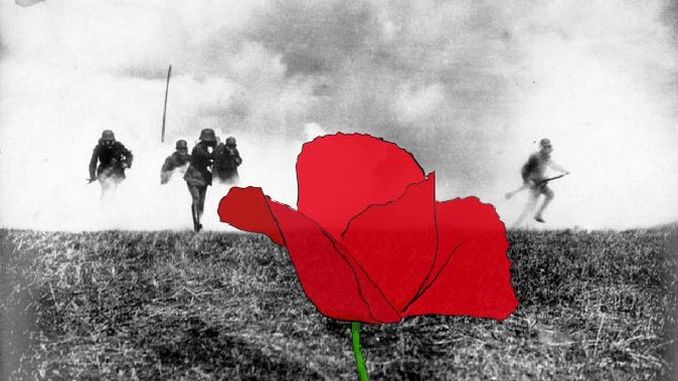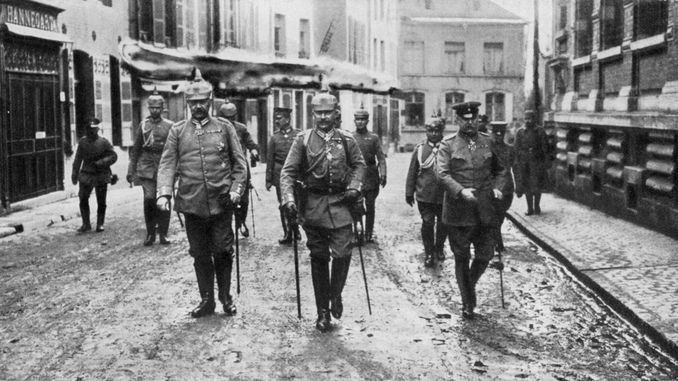
The Kaiser’s world was about to fall apart. The Great War would bring total mobilization and upheaval in Germany, Austria-Hungary, and Russia, plus a new social and world order.
At the beginning of the 20th century, two blocks all armed to a maximum stood against each other. England, France, and Russia (“Triple Entente”) on one side, Germany, Austria-Hungary and Italy (“Dreibund”) on the other. Austria-Hungary, the Habsburg Empire, the multi-ethnic-state, was quite an anachronism, and about to fall apart.
1914
In the East, the Balkans were a “powder keg“ that could explode any time.
Fatal shots in Sarajevo
On June 28, 1914, in Sarajevo, a Serbian nationalist shot the heir to the throne of Austria-Hungary Franz-Ferdinand and his wife Sophie. The traces led to Serbia, to a secret society “Union or Death”, better known as the “Black Hand”.
While one was celebrating the summer, hectic diplomatic activity was going on behind the scenes. Military leaders were secretly planning for a war.

But diplomacy failed. On July 28, Austria-Hungary declared war on Serbia. Within a week, Serbia, Russia, France, and Great Britain on one side, and Germany and Austria-Hungary on the other were at war. All over Europe, people believed that they had to defend their countries against their enemies.

The Western Front
The German troops occupied a large part of Belgium and the North East of France and hoped for a quick victory. But in the Battle of the Marne, September 1914) French and British forces stopped them.
A grueling war of attrition began. Millions of strained and exhausted soldiers on both sides dug into trenches. Most military leaders believed in offensives and ordered frontal assaults, yet machine guns and rapid-firing artillery, used in combination with trenches and barbed wire emplacements gave a crucial advantage to the defense. Huge numbers of soldiers perished in frontal assaults. Commanders on both sides failed to develop tactics for breaching entrenched positions without heavy casualties. In time, however, technology began to produce new offensive weapons, such as gas warfare and the tank.
Since February 1916, a murderous battle was raging at Verdun. The two friends August Macke and Franz Marc had volunteered to the front, but they would not come back. Macke died in September 1914 in Champagne, Marc during the battle of Verdun in March 1916.

1917
The High Command takes over
At that time, Emperor William II was no longer in control. The third German High Command, General Paul von Hindenburg and Erich Ludendorff, made all decision. They convinced William to declare unrestricted submarine warfare against all foreign ships. In vain, Chancellor Bethmann-Hollweg warned that in that case the USA would enter the war on the Allies’ side.
US neutrality
The United States had remained neutral until now. President Woodrow Wilson had run his election campaign in 1916 on the slogan “He kept us out of war!” Certainly, the democracy USA had more sympathies for the England and France than for Imperial Germany and Austria, but most Americans wanted to stay out of war. However, the “Rape of Belgium” and the sinking of the RMS Lusitania had turned public opinion against Germany.
Economically, the USA were long involved. The Allies relied on US supplies and armaments, and loans to pay for them. Many Americans wanted America to be better prepared for hostilities. Wilson warned that the United States would not tolerate unrestricted submarine warfare, in violation of international law. Some openly opted for intervention, like former President Theodore Roosevelt.
Unrestricted submarine warfare begins
But soon Hindenburg and Ludendorff got their way. Overruling chancellor Bethmann-Hollweg’s warnings, Kaiser Wilhelm II agreed that from February 1 onwards, submarine warfare should be unrestricted and overtly so. U-boats had permission to sink without warning all ships except passenger vessels.
President Wilson broke diplomatic relations with Germany and asked Congress for arming merchant ships and all measures that were necessary to protect the U.S. He still adhered to a policy of “armed neutrality”.
The USA enters the war
A month later, the American public learned about the Zimmermann telegram, a German offer to Mexico to side up against the USA. British intelligence had intercepted it. In case of victory, Mexico could regain Texas, New Mexico, and Arizona from the USA.
The President and his fellow Americans were outraged. Across the nation, support grew for intervention. By the end of March, Wilson’s cabinet unanimously advised war. On April 2, President Wilson asked Congress to declare war against Germany.
No peace resolution
The longer the war lasted and the more victims it claimed, the more people at home suffered. Social tensions broke out again and general strikes in armament factories occurred. People had to work very hard for minimal wages, and they had almost nothing to eat due to a British naval blockade in the Northern Sea.
The Social Democrat faction in the Reichstag split over the question of further credits to finance the war. Politicians around Matthias Erzberger of the Catholic Center Party demanded a truce of understanding. With the votes of Social Democrats, the Center Party and the Progressive People’s Party the Reichstag passed a peace resolution in July 1917. The High Command, however, considered it an admission of weakness and enforced Chancellor Bethmann-Hollweg’s dismissal. From now on, General Ludendorff dictated German policy.
1918
Peace through victory in the East
On the Eastern front, Russia’s army had mounted several offensives, but had not succeeded in breaking through German lines. At home in Russia, demoralized by defeat, hunger and great need, people lost all confidence in its Czar and his unpopular German-born wife, Alexandra. In February 1917, he was forced to abdicate. But the new Government continued the war until October 1917, the Bolshevist Revolution. The Germans secretly had helped Lenin to travel from his exile in Switzerland to St. Petersberg, hoping for him destabilize Russia and get the enemy at the Eastern front out of the war.
Lenin offered peace in November 1917, but for months the fighting continued. Eventually, in March 1918 at Brest-Litowsk, the Bolshevists signed the very hard “peace through victory” treaty.
Spring offensive
Yet, the war would be decided at the Western Front. Now that Germany could withdraw large numbers of troops, aero planes and artillery from the Eastern front, the High Command planned a final offensive that should bring victory, They knew well that Germany could not win against a steadily growing Allied superiority of material and men.
On March 21, 1918, the German spring offensive began with intensive artillery bombardments, poison gas and smoke shells.
Wilson’s “Fourteen Points”
The High Command outright rejected the “Fourteen Points” set out by the American President Woodrow Wilson. In an address to the US Congress in January 1918. Wilson had outlined Fourteen Points that could ensure a stable, long-lasting peace not only in Europe, but worldwide. Among them were freedom of the seas, the restoration of territories conquered during the war and the right to national self-determination. Wilson understood that international stability was important to American security and global commerce. Wilson, liberal, democratic and idealistic, wanted peace without victors or conquered.
Hundred Days Offensive
After initial German limited territorial gains, the Allied forces halted the drive. On July 15, 1918, in the Second Battle of the Marne, a huge number of soldiers were killed, and the last reserves were burnt up.
The tide of war decisively turned towards the Allies, they regained much of France and Belgium in the months that followed. By now Britain and France had large numbers of tanks at their disposal, whereas Germany had only a few. The Allied counteroffensive, known as the Hundred Days Offensive, began on 8 August 1918, with the Battle of Amiens. Masses of light tanks forced the Germans into a hasty retreat. Military defeat was inevitable.
At the same time, the multi-ethnic state of Austria-Hungary was falling apart and asked for armistice.
Democratization from above
In October, the High Command told Kaiser Wilhelm II that there was no more hope. They even insisted that Germany had to ask for an armistice based on Wilson’s “Fourteen Points”.
However, it was clear that President Wilson would not negotiate with the Imperial authorities. So the High Command suggested a “democratization from above”, that is to say the Kaiser would offer the democratic political parties to participate in a new government under the liberal-minded prince Max of Baden. That was nothing but cynical political calculation because that way the democratic parties would have to face the disastrous consequences of the defeat, whereas nobody would hold the Imperial authorities and the High Command responsible. Later, Ludendorff and Hindenburg would pretend that the army had been undefeated in combat, but “stabbed in the back” by revolutionists and strikers at home.
By the “October reforms”, Germany became a constitutional monarchy whose Chancellor, Max von Baden, was responsible to the Reichstag. For the first time, Social Democrats got into the government. Only now did the High Command reveal the full truth to them. The situation was hopeless, an armistice had to be made at any conditions.
Armistice
A democratic politician should represent Germany, Matthias Erzberger of the Center Party. It was a very difficult task because whole regions in the north-east of France and Belgium were devastated and had become a hostile environment for years due to mines and poisonous gas. Still in retreat, the German troop leaders had given orders to burn down everything. On November 11, 1918, the armistice was signed in Compiègne, France.
Kaiser Wilhelm in exile
By then, Kaiser Wilhelm II was already history, although he had not yet formally abdicated. On November 10, at dawn, he fled from headquarters in Spa, Belgium, to the neutral Netherlands. Queen Wilhelmina granted him asylum and did not extradite him even at the insistence of the Allies. However, he could not leave his property in the Netherlands.
20th century
The short 20th century | The Great War | German Revolution 1918/19 | Occupation of the Rhineland | Weimar Republic | Nazi Germany | World War II | Federal Republic of Germany
References
The following pictures are from the German Wikipedia allemande, licenced Creative Commons Attribution-Share Alike 3.0 Germany.
- Deutsche Infanterie während eines Gasangriffs in Flandern, Bundesarchiv, Bild 183-R05923 / CC-BY-SA 3.0
- Etricourt, Soldat zwischen beschädigten Gebäuden, Attribution: Bundesarchiv, Bild 104-0608A / CC-BY-SA 3.0
The other pictures are also from the German Wikipedia, public domain section.

Be the first to comment